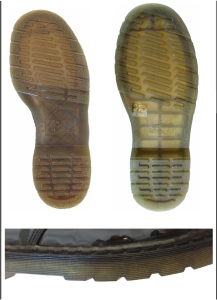 Dr. Martens v. Chinese Laundry
Dr. Martens v. Chinese Laundry
Those of us who grew up in the 1990s will always remember Dr. Martens boots. I’m sure I’ll soon hear that they’re back in style, or that they went in and out of style as I was writing this post, or that they never went out of style. I never had Doc Martens; I’m more of a Clarks Desert Boots kind of guy. But apparently plenty of others have had them; AirWair International Ltd. (the manufacturer of Dr. Martens) claims to have sold millions of pairs in the US since 1984.
Befitting their fearsome, punk rock image, AirWair is known to be aggressive in protecting its intellectual property. They recently filed suit in the US District Court for the Northern District of California against a rival footwear maker, Chinese Laundry, for allegedly infringing the distinctive, Federally-registered trade dress associated with the famous Doc Martens boots. The full text of AirWair’s complaint can be found here. Read on for more details about the trade dress issues in this case.
Trade dress is similar to a trademark, but it relates to the look and feel of a product’s packaging. In its complaint, AirWair cites five trade dress marks registered with the United States Patent and Trademark Office (USPTO):
- “[T]he combination of yellow stitching in the welt area and a two-tone grooved sole edge” (Reg. No. 2,437,751)
- The yellow “welt stitch located around the perimeter of footwear” (Reg. No. 2,437,750)
- The DMS undersole design mark (Reg. No. 2,102,468)
- “[T]he design of an [sic] sole edge including longitudinal ribbing, and a dark color band over a light color” (Reg. No. 2,104,349)
- “[L]ongitudinal ribbing and a dark color band over a light color on the outer sole edge, welt stitching, and a tab at the top back heel of footwear” (Reg. No. 2,341,976)
Yes, these types of shoe design elements can be protected. But that’s not to say that you can’t produce a shoe or boot with yellow stitching or a ribbed sole edge. From AirWair’s complaint:
The Infringing Footwear unlawfully copies and uses the distinctive Dr. Martens Trade Dress, including the two-tone grooved sole edge and DMS undersole pattern. The overall configuration and appearance of the Infringing Footwear is virtually identical to the iconic Dr. Martens 1460 boot, and the DMS undersole pattern, as shown below, and is likely to cause confusion as to the source, sponsorship or origin of the Infringing Footwear…Chinese Laundry’s conduct in copying AirWair’s registered Trade Dress Marks has been systematic and deliberate. Chinese Laundry has copied the Trade Dress and the overall style and configuration of Dr. Martens boots and shoes as closely as possible in a deliberate and calculated attempt to trade upon the popularity and distinctive appearance and design of Dr. Martens footwear. [The italics are mine.]
AirWair’s claim isn’t just that Chinese Laundry made black boots, or that there are some vaguely similar elements. It’s that the overall configuration and appearance was chosen to deceive the public and to cause confusion as to the source of the boots.
Judge for yourself: I’ve included images above of (left) the Dr. Martens boot above the Chinese Laundry boot, and (right) the Dr. Martens sole to the left of the Chinese Laundry sole, and a side view of the tread on the Chinese Laundry sole.
As usual, my prediction is that this will never go to trial, that Chinese Laundry will pull their boots off the market, and that will be that. However, just to satisfy my own curiosity, I’d like to see the case proceed and reach a judicial determination of the scope of trade dress protection for elements in an item of apparel. Now that the Christian Louboutin v. Yves Saint Laurent “red sole” case is finally over, the trademark world needs another footwear battle to occupy our attention.
Finally, I always like to acknowledge when one of my readers tips me off to a potential blog story, so for this one, I’d like to say “Thanks, mom!”

